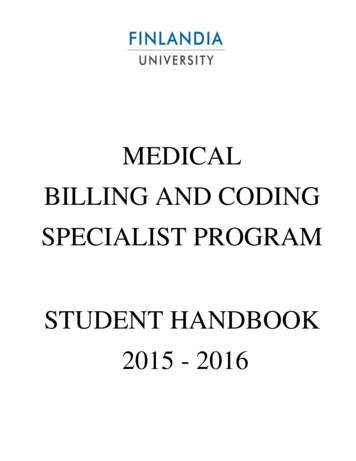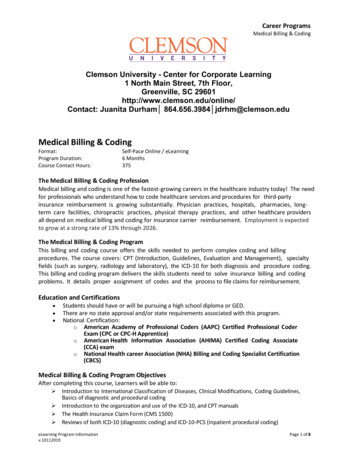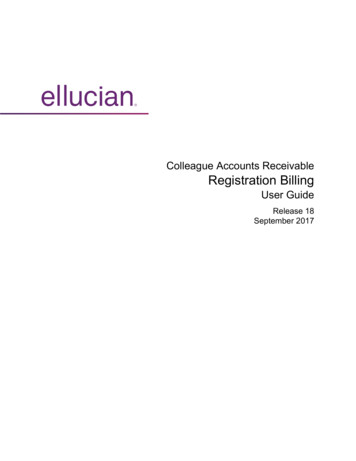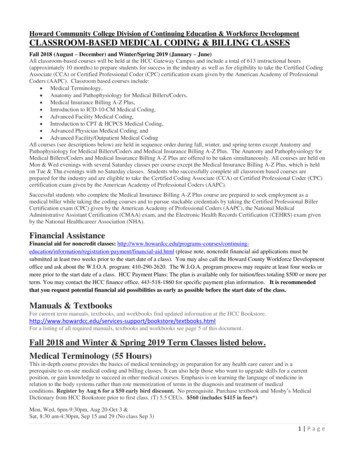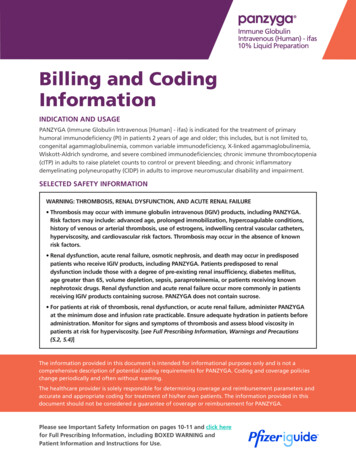
Transcription
Billing and CodingInformationINDICATION AND USAGEPANZYGA (Immune Globulin Intravenous [Human] - ifas) is indicated for the treatment of primaryhumoral immunodeficiency (PI) in patients 2 years of age and older; this includes, but is not limited to,congenital agammaglobulinemia, common variable immunodeficiency, X-linked agammaglobulinemia,Wiskott-Aldrich syndrome, and severe combined immunodeficiencies; chronic immune thrombocytopenia(cITP) in adults to raise platelet counts to control or prevent bleeding; and chronic inflammatorydemyelinating polyneuropathy (CIDP) in adults to improve neuromuscular disability and impairment.SELECTED SAFETY INFORMATIONWARNING: THROMBOSIS, RENAL DYSFUNCTION, AND ACUTE RENAL FAILURE Thrombosis may occur with immune globulin intravenous (IGIV) products, including PANZYGA.Risk factors may include: advanced age, prolonged immobilization, hypercoagulable conditions,history of venous or arterial thrombosis, use of estrogens, indwelling central vascular catheters,hyperviscosity, and cardiovascular risk factors. Thrombosis may occur in the absence of knownrisk factors. Renal dysfunction, acute renal failure, osmotic nephrosis, and death may occur in predisposedpatients who receive IGIV products, including PANZYGA. Patients predisposed to renaldysfunction include those with a degree of pre-existing renal insufficiency, diabetes mellitus,age greater than 65, volume depletion, sepsis, paraproteinemia, or patients receiving knownnephrotoxic drugs. Renal dysfunction and acute renal failure occur more commonly in patientsreceiving IGIV products containing sucrose. PANZYGA does not contain sucrose. For patients at risk of thrombosis, renal dysfunction, or acute renal failure, administer PANZYGAat the minimum dose and infusion rate practicable. Ensure adequate hydration in patients beforeadministration. Monitor for signs and symptoms of thrombosis and assess blood viscosity inpatients at risk for hyperviscosity. [see Full Prescribing Information, Warnings and Precautions(5.2, 5.4)]The information provided in this document is intended for informational purposes only and is not acomprehensive description of potential coding requirements for PANZYGA. Coding and coverage policieschange periodically and often without warning.The healthcare provider is solely responsible for determining coverage and reimbursement parameters andaccurate and appropriate coding for treatment of his/her own patients. The information provided in thisdocument should not be considered a guarantee of coverage or reimbursement for PANZYGA.Please see Important Safety Information on pages 10-11 and click herefor Full Prescribing Information, including BOXED WARNING andPatient Information and Instructions for Use.
Table of ContentsIntroduction and Pfizer IGuideTM Hub3Coding for PANZYGA4 International Classification of Diseases, Tenth Revision, ClinicalModification (ICD-10-CM) Diagnosis Codes4 Healthcare Common Procedure Coding System (HCPCS) Codes6 PANZYGA National Drug Codes (NDC)6 Current Procedural Terminology (CPT ) Codes6 Codes for Home Infusion/Specialty Pharmacies7Sample Claim Form8PANZYGA Co-Pay Program9Indication and Usage and Important Safety Information10Please see Important Safety Information on pages 10-11 and click herefor Full Prescribing Information, including BOXED WARNING andPatient Information and Instructions for Use.2
Introduction andPfizer IGuideTM HubFor your patient claim submissions for PANZYGA, Pfizer is committed to providingbilling and coding information for the following FDA-approved indications:1Chronic inflammatory demyelinating polyneuropathy (CIDP) in adults2Primary humoral immunodeficiency (PI) in patients 2 years of age and older3Chronic immune thrombocytopenia (cITP) in adultsWe have developed this guide to provide youwith general coding information and claimssubmission details for PANZYGA.When you’ve decided PANZYGA is appropriate for your patient, Pfizer IGuideTM may help.Enroll your patients in Pfizer IGuideTM for supportThe Pfizer IGuideTM team can:Conduct a benefits verificationto determine your patient’scoverage for PANZYGAincluding out-of-pocket costsDetermine payer requirementsand provide information aboutthe prior authorization processand appeals process as needed*Enroll eligible patientswithin the PANZYGACo-Pay Program†If you have any questions or need additional assistance, please call Pfizer IGuide at 1-844-448-4337, 8 am to 8 pm ET, Monday through Friday*Please note where a PA is required, the physician must submit required information directly to the patient’s insurer.Terms and conditions apply. Patients must be 2 years or older to be eligible. Patients must have commercial insurance to be eligible. Patients arenot eligible if they are enrolled in a state or federal insurance program. Click here for full Terms and Conditions.†Please see Important Safety Information on pages 10-11 and click herefor Full Prescribing Information, including BOXED WARNING andPatient Information and Instructions for Use.3
Coding for PANZYGAThis section describes the types of codes that are likely to be most relevant to claimsfor PANZYGA. PANZYGA is a solution for infusion to be administered intravenously (IV)in an infusion center, physician’s office, or at home by a trained healthcare provider.International Classification of Diseases, Tenth Revision, Clinical Modification(ICD-10-CM)1ICD-10-CM diagnosis codes are used for identifying and documenting a patient’s specific diagnosis.These codes are used by all healthcare providers, and are recognized by all insurers. Local coveragedeterminations and articles should be consulted for additional covered indications.D69Purpura and other hemorrhagic conditionsD69.3Immune thrombocytopenia purpuraHemorrhagic (thrombocytopenic) purpuraIdiopathic thrombocytopenic purpuraTidal platelet dysgenesisD80D80.0*D80.1Immunodeficiency with predominantly antibody defectsHereditary hypogammaglobulinemiaAutosomal recessive agammaglobulinemia (Swiss type)X-linked agammaglobulinemia [Bruton] (with growth hormone deficiency)Nonfamilial hypogammaglobulinemiaAgammaglobulinemia with immunoglobulin-bearing B-lymphocytesCommon variable agammaglobulinemia [CVAgamma]Hypogammaglobulinemia NOSD80.2*Selective deficiency of immunoglobulin A [IgA]D80.3*Selective deficiency of immunoglobulin G [IgG] subclassesD80.4*Selective deficiency of immunoglobulin M [IgM]D80.5*Immunodeficiency with increased immunoglobulin M [IgM]D80.6*Antibody deficiency with near-normal immunoglobulins or with hyperimmunoglobulinemiaD80.8Other immunodeficiencies with predominantly antibody defectsKappa light chain deficiencyD80.9Immunodeficiency with predominantly antibody defects, unspecifiedD81Combined immunodeficienciesD81.0*Severe combined immunodeficiency [SCID] with reticular dysgenesisD81.1*Severe combined immunodeficiency [SCID] with low T- and B-cell numbersD81.2*Severe combined immunodeficiency [SCID] with low or normal B-cell numbersD81.4Nezelof’s syndromeTable continues on the next page.Please see Important Safety Information on pages 10-11 and click herefor Full Prescribing Information, including BOXED WARNING andPatient Information and Instructions for Use.4
Coding for PANZYGA(continued)D81Combined immunodeficiencies (continued)D81.5*Purine nucleoside phosphorylase [PNP] deficiencyD81.6*Major histocompatibility complex class I deficiencyBare lymphocyte syndromeD81.7*Major histocompatibility complex class II deficiencyD81.89*Other combined immunodeficienciesD81.9*Combined immunodeficiencies, unspecifiedSevere combined immunodeficiency disorder [SCID] NOSD82Immunodeficiency associated with major other defectsD82.0*Wiskott-Aldrich syndromeImmunodeficiency with thrombocytopenia and eczemaD82.1*Di George’s syndromePharyngeal pouch syndromeThymic alymphoplasiaThymic aplasia or hypoplasia with immunodeficiencyD82.2Immunodeficiency with short-limbed statureD82.3Immunodeficiency following hereditary defective response to Epstein-Barr virusX-linked lymphoproliferative diseaseD82.4*Hyperimmunoglobulin E [IgE] syndromeD82.8Immunodeficiency associated with other specified major defectsD82.9Immunodeficiency associated with major defect, unspecifiedD83Common variable immunodeficiencyD83.0*Common variable immunodeficiency with predominant abnormalities of B-cell numbersand functionD83.1*Common variable immunodeficiency with predominant immunoregulatory T-cell disordersD83.2*Common variable immunodeficiency with autoantibodies to B- or T-cellsD83.8*Other common variable immunodeficienciesD83.9*Common variable immunodeficiency, unspecifiedD84D84.9G11G11.3*G61G61.81Other immunodeficienciesImmunodeficiency, unspecifiedImmunocompromised NOSImmunodeficient NOSImmunosuppressed NOSHereditary ataxiaCerebellar ataxia with defective DNA repairAtaxia telangiectasia [Louis-Bar]Inflammatory polyneuropathyChronic inflammatory demyelinating polyneuritis*Medicare Part B-approved diagnosis codes for treatment with PANZYGA in the home. All other diagnoses may qualify forcoverage under Medicare Part D plans.2Please see Important Safety Information on pages 10-11 and click herefor Full Prescribing Information, including BOXED WARNING andPatient Information and Instructions for Use.5
Coding for PANZYGA(continued)Healthcare Common Procedure Coding System (HCPCS) Code3HCPCS codes are used for billing drugs and services to Medicare, Medicaid, and commercial payers. Untila permanent J-code is assigned for PANZYGA, the miscellaneous code below may be used.CodeDescriptionJ1599Injection, immune globulin, intravenous, non-lyophilized (eg, liquid),not otherwise specified, 500 mgAdditionalinformationrequired bymost payerson claim forms: Branded/generic nameStrengthDosage administeredRoute of administrationNational Drug Code (NDC)Some payersmay alsorequest: Package insert Drug purchase invoice Documentation to support medical necessityPANZYGA NDC4An NDC is a universal, unique, 3-segment number identifying drugs by manufacturer, dosage, andpackage size. NDCs are used for billing drugs and biologicals. An NDC allows payers to identify thedrug administered when a miscellaneous J-code is used.Billing NDCCarton NDCConcentration00069-1109-0100069-1109-022.5 g/25 mL00069-1224-0100069-1224-025 g/50 mL00069-1312-0100069-1312-0210 g/100 mL00069-1415-0100069-1415-0220 g/200 mL00069-1558-0100069-1558-0230 g/300 mLCurrent Procedural Terminology (CPT )* Codes5CPT codes describe the medical, surgical, diagnostic, and therapeutic services and procedures.CodeDescription96365IV infusion, for therapy, prophylaxis, or diagnosis (specify substance or drug); initial,up to 1 hour96366IV infusion, for therapy, prophylaxis, or diagnosis (specify substance or drug); each additionalhour (list separately in addition to code for primary procedure)*CPT is a registered trademark of the American Medical Association (AMA). All rights reserved.Please see Important Safety Information on pages 10-11 and click herefor Full Prescribing Information, including BOXED WARNING andPatient Information and Instructions for Use.6
Coding for PANZYGA(continued)CODES FOR HOME INFUSION/SPECIALTY PHARMACIESHome Infusion Therapy3HCPCS per diem S-codes are used by commercial payers and Medicaid to report drugs, services, andsupplies. These codes are not payable by Medicare.CodeDescriptionS9338Home infusion therapy, immunotherapy, administrative services, professional pharmacy services,care coordination and all necessary supplies and equipment (drugs and nursing visits codedseparately), per diemIVIg Demonstration3,6The Medicare IVIg Demonstration provides a bundled payment under Medicare Part B for itemsand services that are necessary for the in-home administration of IVIg for the treatment of PI. J1599(Injection, immune globulin, intravenous, non-lyophilized (eg, liquid), not otherwise specified,500 mg) is covered under the demonstration.The demonstration has been extended through December 31, 2023.CodeDescriptionQ2052Services, supplies and accessories used in the home under the Medicare IVIg demonstrationCodes are subject to change.Please see Important Safety Information on pages 10-11 and click herefor Full Prescribing Information, including BOXED WARNING andPatient Information and Instructions for Use.7
Sample Claim FormThis section offers providers guidance in submitting accurate physician office claimsfor administration of PANZYGA.Sample Physician Office Claim Form (CMS-1500)Item 21: Diagnosis or Natureof Illness or Injury Enter the applicable ICD indicatorto identify which version of ICDcodes is being reported Enter “0” for ICD-10-CM betweenthe vertical, dotted lines in theupper right-hand area of the field Enter appropriate ICD-10-CMdiagnosis code(s) starting onItem 21, Line AItem 24D: Procedures, Services,or Supplies Enter the CPT or HCPCS code(s)from the appropriate code set ineffect on the date of service Enter applicable HCPCS codes(J1599, Q2052) Include applicable CPT codesfor IV infusion (96365, 96366) For applicable Medicare claims,enter the JW modifier*, on aseparate claim line (J1599-JW)Item 24E: Diagnosis Pointer Enter the diagnosis code referenceletter(s) (pointer) as shown inItem 21 to relate the date of serviceand the procedures performed tothe primary diagnosis. The referenceletter(s) should be A–L For Medicare claims, only 1-lineletter from Item 21 should beentered in Item 24E for eachHCPCS code reported in Item 24DItem 24G: Days or Units Enter the number of unitsadministered for each line item If applicable, enter the number ofunits discarded, on the separateclaim line with the JW modifier* PANZYGA should be billed basedon units, not the number ofmilligrams One unit represents 500 mgof PANZYGA, therefore,1 g 2 units*JW – Drug amount discarded/not administered to any patient.3Please see Important Safety Information on pages 10-11 and click herefor Full Prescribing Information, including BOXED WARNING andPatient Information and Instructions for Use.8
PANZYGA Co-Pay ProgramPANZYGA Co-Pay Assistance IsAvailable for Eligible Patients*Eligible, commercially insured patients may reduceout-of-pocket costs by up to 5,000 per year or the cost ofa patient’s co-pay in a 12-month period, whichever is less.* Terms and conditions apply. Patients must be 2 years or older to be eligible. Patients must havecommercial insurance to be eligible. Patients are not eligible if they are enrolled in a state orfederal insurance program.Click here for full Terms and Conditions.If you have any questions about theavailable co-pay assistance through thePANZYGA Co-Pay Program, please callPfizer IGuide at 1-844-448-4337,8 am to 8 pm ET, Monday through Friday.Please see Important Safety Information on pages 10-11 and click herefor Full Prescribing Information, including BOXED WARNING andPatient Information and Instructions for Use.9
Indication and Usage andImportant Safety InformationINDICATION AND USAGEPANZYGA (Immune Globulin Intravenous [Human] - ifas) is indicated for the treatment of primaryhumoral immunodeficiency (PI) in patients 2 years of age and older; this includes, but is not limited to,congenital agammaglobulinemia, common variable immunodeficiency, X-linked agammaglobulinemia,Wiskott-Aldrich syndrome, and severe combined immunodeficiencies; chronic immunethrombocytopenia (cITP) in adults to raise platelet counts to control or prevent bleeding; and chronicinflammatory demyelinating polyneuropathy (CIDP) in adults to improve neuromuscular disabilityand impairment.IMPORTANT SAFETY INFORMATIONWARNING: THROMBOSIS, RENAL DYSFUNCTION, AND ACUTE RENAL FAILURE Thrombosis may occur with immune globulin intravenous (IGIV) products, including PANZYGA.Risk factors may include: advanced age, prolonged immobilization, hypercoagulableconditions, history of venous or arterial thrombosis, use of estrogens, indwelling centralvascular catheters, hyperviscosity, and cardiovascular risk factors. Thrombosis may occur in theabsence of known risk factors. Renal dysfunction, acute renal failure, osmotic nephrosis, and death may occur in predisposedpatients who receive IGIV products, including PANZYGA. Patients predisposed to renaldysfunction include those with a degree of pre-existing renal insufficiency, diabetes mellitus,age greater than 65, volume depletion, sepsis, paraproteinemia, or patients receiving knownnephrotoxic drugs. Renal dysfunction and acute renal failure occur more commonly in patientsreceiving IGIV products containing sucrose. PANZYGA does not contain sucrose. For patients at risk of thrombosis, renal dysfunction, or acute renal failure, administerPANZYGA at the minimum dose and infusion rate practicable. Ensure adequate hydrationin patients before administration. Monitor for signs and symptoms of thrombosis andassess blood viscosity in patients at risk for hyperviscosity. [see Full Prescribing Information,Warnings and Precautions (5.2, 5.4)]Please click here for Full Prescribing Information, including BOXED WARNINGand Patient Information and Instructions for Use.10
Indication and Usage andImportant Safety InformationIMPORTANT SAFETY INFORMATION (CONTINUED)ContraindicationsPANZYGA is contraindicated in patients who have a history of severe systemic hypersensitivityreactions, such as anaphylaxis, to human immunoglobulin and in IgA-deficient patients with antibodiesagainst IgA and history of hypersensitivity.Warnings and PrecautionsMonitor renal function, including blood urea nitrogen and serum creatinine, and urine output inpatients at risk of developing acute renal failure.Hyperproteinemia, increased serum osmolarity, and hyponatremia may occur in patients receivingPANZYGA.Aseptic meningitis syndrome may occur in patients receiving PANZYGA, especially with high doses orrapid infusion.Hemolysis that is either intravascular or due to enhanced red blood cell sequestration can developsubsequent to PANZYGA treatments. Risk factors for hemolysis include high doses and non-O-bloodgroup. Closely monitor patients for hemolysis and hemolytic anemia.Monitor patients for pulmonary adverse reactions (transfusion-related acute lung injury [TRALI]).Monitor blood pressure prior to, during, and following PANZYGA infusion.Carefully consider the relative risks and benefits before prescribing the high dose regimen (for cITP) inpatients at increased risk of volume overload.PANZYGA is made from human plasma and may contain infectious agents, e.g. viruses andtheoretically, the Creutzfeldt-Jakob disease agent.Adverse ReactionsPI – The most common adverse reactions ( 5% study subjects) were headache, nausea, fever, fatigue,and abdominal pain.cITP in adults – The most common adverse reactions ( 5% study subjects) were headache, fever, nausea,vomiting, dizziness, and anemia.CIDP in adults – The most common adverse reactions reported in greater than 5% of subjects were:headache, fever, dermatitis, and blood pressure increase.The risk information provided here is not comprehensive; see full Prescribing Information and BoxedWarning for PANZYGA.You are encouraged to report adverse events related to Pfizer products by calling 1-800-438-1985(US only). If you prefer, you may contact the US Food and Drug Administration (FDA) directly.Visit www.fda.gov/MedWatch or call 1-800-FDA-1088.Please click here for Full Prescribing Information, including BOXED WARNING and Patient Informationand Instructions for Use.11
References1. National Center for Health Statistics (US Department of Health and Human Services). International Classification ofDiseases, Tenth Revision, Clinical Modification (ICD-10-CM). 2021 Codes Tables and Index. Accessed April 20, 2021.https://www.cdc.gov/nchs/icd/icd10cm.htm2. CMS.gov. Local coverage article for billing and coding: immune globulin intravenous (IVIg) (A57187). Accessed April 20,2021. ails/article-details.aspx?articleId 57187&ver 11&SearchType Advanced&CoverageSelection Local&ArticleType BC%7cSAD%7cRTC%7cReg&PolicyType Both&s All&KeyWord 0636&KeyWordLookUp Doc&KeyWordSearchType Exact&kq true&bc EAAAAAgAAAAA&3. Centers for Medicare and Medicaid Services (US Department of Health and Human Services). HCPCS Release & CodeSets. Accessed April 20, 2021. deSets/Alpha-Numeric-HCPCS4. PANZYGA. Prescribing information. Pfizer Inc; 2021. Accessed April 20, 2021. http://labeling.pfizer.com/ShowLabeling.aspx?id 123555. American Medical Association. CPT /Medicare Payment Search. Accessed April 20, 2021. tSearch.do6. Medicare Intravenous Immune Globulin (IVIG) Demonstration: Supplier frequently asked questions. Cms.gov. AccessedApril 30, 2021. supplierfaqPANZYGA is a registered trademark of Octapharma AG.PP-PAN-USA-0159 2021 Pfizer Inc.All rights reserved.July 2021
Healthcare Common Procedure Coding System (HCPCS) Code3 HCPCS codes are used for billing drugs and services to Medicare, Medicaid, and commercial payers. Until a permanent J-code is assigned for PANZYGA, the miscellaneous code below may be used. Billing NDC Carton NDC Concentration 00069-1109-01 00069-1109-02 2.5 g/25 mL

